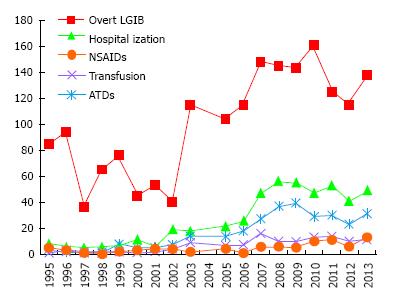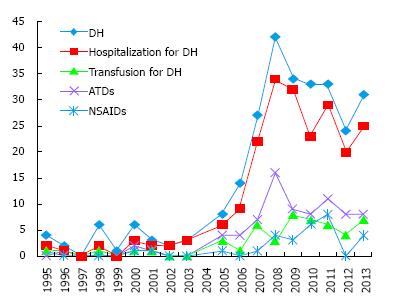Copyright
©The Author(s) 2016.
World J Gastrointest Pharmacol Ther. Aug 6, 2016; 7(3): 440-446
Published online Aug 6, 2016. doi: 10.4292/wjgpt.v7.i3.440
Published online Aug 6, 2016. doi: 10.4292/wjgpt.v7.i3.440
Figure 1 Annual totals and changes over time in number of patients undergoing colonoscopy for overt lower gastrointestinal bleeding, requiring hospitalization, requiring transfusions, and using antithrombotic drugs and nonsteroidal anti-inflammatory drugs (1995 to 2013).
The incidence of lower gastrointestinal bleeding (LGIB) started to increase rapidly in 2002-2003, associated with increases in the number of patients hospitalized, receiving blood transfusions, using antithrombotic drugs (ATDs), and using nonsteroidal anti-inflammatory drugs (NSAIDs).
Figure 2 Changes in the number of patients with colonic diverticular hemorrhage: Number of patients requiring hospitalization, requiring transfusion, and using antithrombotic drugs or nonsteroidal anti-inflammatory drugs (1995 to 2013).
The number of patients with diverticular hemorrhage (DH) started to increase rapidly in 2003, and peaked in 2008. This was associated with an increase in the number of patients hospitalized, receiving blood transfusions, using antithrombotic drugs (ATDs), and using nonsteroidal anti-inflammatory drugs (NSAIDs).
- Citation: Kinjo K, Matsui T, Hisabe T, Ishihara H, Maki S, Chuman K, Koga A, Ohtsu K, Takatsu N, Hirai F, Yao K, Washio M. Increase in colonic diverticular hemorrhage and confounding factors. World J Gastrointest Pharmacol Ther 2016; 7(3): 440-446
- URL: https://www.wjgnet.com/2150-5349/full/v7/i3/440.htm
- DOI: https://dx.doi.org/10.4292/wjgpt.v7.i3.440










